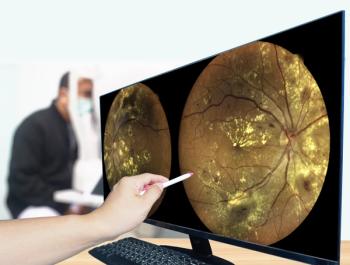
Ultra-widefield OCT ‘may be the only imaging’ needed to manage PDR
Proliferative diabetic retinopathy (PDR) is defined by the presence of neovascularization; the use of ultra-widefield (UWF) imaging has shown the distribution of this neovascularization and other diabetic retinopathy (DR) lesions in the posterior and peripheral retina.
Proliferative diabetic retinopathy (PDR) is defined by the presence of neovascularization; the use of ultra-widefield (UWF) imaging has shown the distribution of this neovascularization and other diabetic retinopathy (DR) lesions in the posterior and peripheral retina. Some of these lesions are outside the typical sevel ETDRS imaging fields.
Neovascularization may be easier to identify on UWF than on 7-ï¬eld conventional color fundus imaging or on UWF color images alone because UWF ï¬uorescein angiography (FA) has a very wide ï¬eld of view, lacks the pseudocoloration artifact of UWF photos, and UWF FA provides temporal information regarding ï¬uorescein leakage that assists in differentiating NV from other DR lesions such as intraretinal microvascular abnormalities (IRMAs).1
In a retrospective, consecutive case series, Russell et al. identified and compared areas of neovascularization in PDR on UWF FA with a simulated wideï¬eld (WF) swept-source optical coherence tomography angiography (SS-OCTA) ï¬eld of view to determine whether the WF SS-OCTA ï¬eld of view was sufï¬cient for detection of NV in PDR.
Neovascularization elsewhere in PDR was most prevalent superotemporally, and 99.4% of treatment-naive eyes had NV within the simulated WF SS-OCTA ï¬eld of view. Combined with previous research using WF SS-OCTA to identify neovascularization in PDR, these ï¬ndings suggest that WF SS-OCTA may be the only imaging modality needed for the diagnosis and longitudinal management of PDR.
“Neovascularization of the disc does not reï¬ect more advanced PDR than NV elsewhere alone, or at the very least, that once an eye has undergone treatment, the presence or absence of neovascularization of the disc is not indicative of PDR severity,” the group suggested.
Study details
All patients with PDR and UWF FA imaging at the Bascom Palmer Eye Institute over a period of 5.5 years were identiï¬ed. UWF FA images were reviewed and sites of NV were identiï¬ed either as NV of the disc or NV elsewhere. Sites of NV elsewhere were classiï¬ed by disc-centered retinal quadrants. A simulated WF SS-OCTA montage ï¬eld of view was overlaid on the UWF FA images to determine whether sites of NV would have been identiï¬ed by this simulated WF SS-OCTA ï¬eld of view.
To simulate the ï¬eld of view that could be obtained using WF SS-OCTA, two fovea-centered boxes were overlaid onto each representative UWF FA image. To overcome the lack of scale on the UWF FA images, the simulated SS-OCTA ï¬eld of view was scaled based on the disc-to-fovea distance.
A total of 1,011 patients had at least 1 visit with an ICD code of PDR and a CPT code for FA. All frames from 1,253 UWF FAs were reviewed, and NV was identiï¬ed in 825 UWF FAs from 433 patients (651 eyes). These 651 eyes were stratiï¬ed into 330 treatment-naive PDR eyes and 321 previously treated PDR eyes.
A total of 651 eyes with PDR from 433 patients had at least 1 UWF FA with NV. Of the 651 eyes, 50% were treatment-naïve, 9.8% had NV of the disc only, 41.8% had NV elsewhere only, and 48.4%had both NV of the disc and NV elsewhere. NV else-where was most prevalent in the superotemporal quadrant and the least prevalent in the nasal quadrants.
When the simulated WF SS-OCTA ï¬eld of view was overlaid on the UWF FA, 98.3% of all eyes, 99.4% of treatment-naive eyes, and 97.2% of previously treated eyes had NV within the WF SS-OCTA ï¬eld of view. In those eyes with a repeat UWF FA within 6 to 18 months of the ï¬rst FA, the distribution of NV did not change in either the treatment-naive or previously treated eyes.
“We found that approximately 10% of PDR eyes had NV of the disc only, 40% had both NV of the disc and NV elsewhere, and 50% had NV elsewhere only,” the authors wrote.
The present study found 20% of treatment-naive and 17% of previously treated eyes with NV of the disc had no NV elsewhere. It is widely believed that NV of the disc represents a more advanced stage of PDR that develops after NV elsewhere. The higher frequency of NV of the disc (50%) in the present study versus 37% in the study by Jansson and associates would be consistent with the belief that the current study population had more advanced disease.
However, if NV of the disc represents a more advanced stage of PDR, and treatment of PDR was expected to cause regression to less advanced stages, less NV of the disc in the previously treated group would be expected compared with the treatment-naive eyes and less NV of the disc in the follow-up (post-treatment) UWF FA images compared to the baseline UWF FA images; but these differences were not observed.
The changes in neovascularization as detected by WF SS-OCTA can provide clinically useful information about whether the treatment has induced stabilization, regression, or progression of the neovascularization.
Although an acknowledged limitation to the study was its retrospective nature, the authors purported that the retrospective nature allowed the inclusion of more eyes that were reflective of real-life clinical practice.
Another potential limitation was that actual WF SS-OCTA was not performed on most eyes, “as this would have been more reliable than a simulated WF SS-OCTA field of view.”
Disclosures:
1. Russell JF, Flynn HW, Jr., Sridhar J, et al. Distribution of diabetic neovascularization on ultra-widefield fluorescein angiography and on simulated widefield OCT angiography. Am J Ophthalmol. 2019.
Newsletter
Keep your retina practice on the forefront—subscribe for expert analysis and emerging trends in retinal disease management.












































